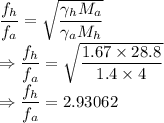
Now consider a pipe that is stopped (i. e., closed at one end) but still has a fundamental frequency of 285 hz in air. how does your answer to part a, fhe, change? view available hint(s) now consider a pipe that is stopped (i. e., closed at one end) but still has a fundamental frequency of 285 in air. how does your answer to part a, , change? a. fhe increases. b. fhe decreases. c. fhe stays the same.

Answers: 3
Other questions on the subject: Physics

Physics, 21.06.2019 18:00, calmicaela12s
Which surface feature of the moon is characterized by mountainous areas? terrae craters maria regolith
Answers: 1

Physics, 21.06.2019 22:00, westes0376
Orque can be calculated by multiplying the force (n) applied at 90? to the lever arm at a distance (m) from the pivot point (point of rotation), the compound si unit for the torque is n? m. if the force (at 90? to the lever arm) applied is 15 n and it is applied at 2.0 m from the pivot point (point of rotation), what is the torque on the lever?
Answers: 3

Physics, 22.06.2019 00:30, powberier6979
Consider an ordinary, helium-filled party balloon with a volume of 2.2 ft3. the lifting force on the balloon due to the outside air is the net resultant of the pressure distribution exerted on the exterior surface of the balloon. using this fact, we can derive archimedes’ principle, namely that the upward force on the balloon is equal to the weight of the air displaced by the balloon. assuming that the balloon is at sea level, where the air density is 0.002377 slug/ft3, calculate the maximum weight that can be lifted by the balloon. note: the molecular weight of air is 28.8 and that of helium is 4.
Answers: 2

Physics, 22.06.2019 17:10, lesok0818
Which statement best describes the superposition principle? a.) if two in-phase waves arrive simultaneously at a point, their amplitudes add up b.) if two out-of-phase waves arrive simultaneously at a point, their amplitudes add up c.) if two in-phase waves arrive at a point one after another, their amplitudes add up d.) if two out-of-phase waves arrive at a point one after another, their amplitudes adds up
Answers: 2
Do you know the correct answer?
Now consider a pipe that is stopped (i. e., closed at one end) but still has a fundamental frequency...
Questions in other subjects:





English, 09.04.2020 03:17


Mathematics, 09.04.2020 03:17


Social Studies, 09.04.2020 03:17

Mathematics, 09.04.2020 03:17


 = Specific heat ratio
= Specific heat ratio










